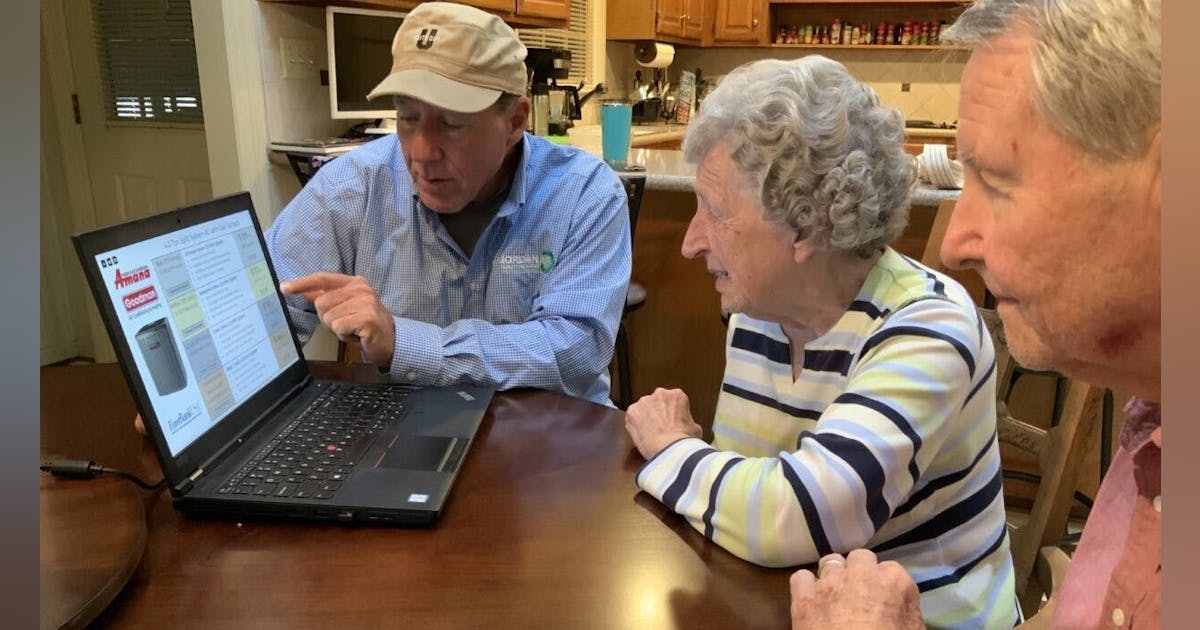All HVAC in-home sales professionals have selling skills. They are trained to do certain things on their calls, say certain things about their products, respond in specific ways when questions are asked, and ask for the sale in a way that will result in an agreement.
Can these skills be improved? Of course. However, two significant challenges prevent improvement: the question of which existing skills could benefit from improvement and the natural reluctance to change what is currently comfortable.
All Comfort Advisors have unique ways of presenting, proposing, and closing. It’s possible, however, that there are some steps you have been consciously skipping and others you may not have been aware of that would improve results.
Here is a process gleaned from thousands of highly effective ride-along calls. This isn’t to say that there aren’t other tactics you might employ, but if you generally follow these fundamentals, then it’s a sure bet that your close rate and average sale will increase.
Planning for Full Engagement with Your Customers
The most effective in-home sales calls are when customers fully engage in the sales process. This isn’t the customers’ responsibility…it’s yours.
Fully engaged customers mean you have asked questions and listened more than you have talked, involved them in discovering their problems, and created unique solutions based on what they have told you is important to them. You will naturally and effectively establish credibility and trust by engaging them in these ways.
Transitioning From Problem Discovery to the Kitchen Table
Emailing customers a “bid, estimate, or quote” has become too easy. It might save time, but doing so relegates your proposal to the same as everyone else’s. Also, some customers may be inclined to rush you through your call. When that happens, anything you cut from your sales process will reduce the likelihood of making the sale. Here is a way to set the stage so customers understand why you asked for this time.
“Well, folks, I’ve asked a lot of questions and have taken notes about your concerns. We have discovered several opportunities to make you more comfortable, save some money on your utility bills, and improve your family’s health. Would there be a place where we could sit, maybe at the kitchen table, so I could prepare some choices for you to consider? It will just take me 15 or 20 minutes to do that.”
Listing a Summary of Their Problems and Concerns
At the kitchen table, handwrite a short list of “pain points” you had discussed with them during your discovery. This should only take you a few minutes.
Pain point terms include:
- Hot and cold spots
- High utility bills
- Noisy…inside and/or outside
- Allergies or health concerns
- History of reliability concerns.
Preparing the Company Presentation
We have three things to sell:
1. Yourself
2. Your Company
3. Your Solutions to Your Customers’ Problems
Most Comfort Advisors will say something positive about their company at some point during the call, but few will take the time for a more professional presentation. If you do this, you will add value by differentiating yourself from other companies. If you don’t already have one, take the time to create a short PowerPoint presentation or record a video about what makes your company unique.
Creating the Proposal Choices
Create four choices that address your customers’ problems and concerns. (For an example, see https://www.silverbullet.ac).
- BEST Solution: The best solution is without a budget in mind… so the customer has all the information she/he might need to decide.
- BETTER Solution: Make this choice the most significant price drop (reduction) with the fewest benefits removed from the BEST Choice.
- GOOD Solution: This is still a good system with the essential products that address the primary customer issues.
- BASIC Solution: This is the current equivalent to what your customers now have.
Present, Propose, and Close
Okay, you have been at the kitchen table for 20-25 minutes. You can do everything described during that time with advanced preparation and practice. Here’s how your presentation might flow:
“OK, folks. I have your information ready. There are four solutions to consider, and I’m sure you will like what you see. They were created based on what we have discussed and what we found was going on with your existing system. Let’s review the list of your concerns first.”
Review each pain point without talking about the solutions. If you have taken photos or videos of specific problems, show them now.
Then, to confirm they agree with what you have said, ask, “So, does all of this summarize the problems we found and your concerns?”
They will say “yes”.
“Thanks. Most people only invest in a new heating and cooling system once in a lifetime and don’t consider how important choosing the right contractor is. Let me take just a few minutes and tell you about our company.”
Using your PowerPoint or Company Video presentation, keep it under four or five minutes. This is very important.
Then, ask, “Do we seem like the kind of company you would be comfortable trusting to take care of your project?”
They will say “yes”.
“Great, let’s look at how we can accomplish all of this.”
Now, take your printed proposal choices from your company folder, or turn your laptop or tablet toward the customers and show all four choices to them simultaneously.
“I have prepared four choices for you. They are all very good. Our BASIC Solution is an upgrade from what you now have and has a tight budget in mind. I’ve also prepared a BEST Solution. This one doesn’t have a budget in mind, but it includes all the information about every possible solution, so you can also consider that. And then I have two in the middle. Please remember that we can mix and match anything to create a customized system.
You can see the investments. (Point to The Total Investment first, then the Monthly Investment.)
We provide all this information so our customers can decide what they want to do. Would it be okay to tell you about the BEST Solution first?”
Matching the Problems to the Solutions
This tactic is often missed. As previously written, what the customer will buy is what you sell. If you present the choices with product descriptions loaded with technical jargon, customers will not likely understand how they will benefit. Here is a way to describe what the customers will receive, including the benefits that come from each part of the system:
“Thanks. The BEST Solution includes an additional return air to the master bedroom. That will allow you to close the door at night and be much more comfortable. This also includes our best equipment that will provide the greatest savings on your utility bills and significantly reduce the air noise that has been bothering you. We included our best air purification system, which has been proven to reduce bacteria and viruses in hospital environments. I have one in my home, which has made a noticeable difference. Finally, the BEST Solution includes a complete 10-year parts and labor warranty so that you will not have any out-of-pocket repair costs for that time, and three years of maintenance where we come out twice a year to check your system for safety, clean it, and even replace your air filters. Customers appreciate that.”
Soft Closing by Giving Customers a Choice
Here, the fun part begins! You have presented the BEST Solution first, matching each product to the problems they will solve. Now, you have earned the right to ask,
“So, do you think you would like this system, or would you like to hear about the BETTER Solution?”
This is an alternative way of “closing” by giving them a choice. After all, it’s the customers’ home, their money, and their choice. Just ask…some will say yes!
Most of the time, they will ask you to tell them about the BETTER Solution. When you describe that one, say,
“So, this Solution saves almost as much money, will provide about the same comfort, and will protect your family’s health. It’s a terrific system. You can see the investment; which would you be leaning toward?”
If they still want to hear about the GOOD Solution, explain what they will receive and emphasize what they won’t. After describing it, use the same Closing question,
“So, which of these three choices would you lean toward?”
Don’t Forget the Importance of Reinforcing Their Decision
Once your customers decide, reinforce their choice with a comment such as, “I know you will be happy with this.”, or “Other customers who have made the same choice really like that system.”
The Effectiveness of Offering Choices
Considering the price difference between the BEST and BETTER Solutions, many customers will choose the BETTER. Over time, by engaging the customers and compellingly presenting the System Solutions as described, you can expect, at a minimum, 20% Best, 30% Better, 30% Good, and 20% Basic. After practice, many Comfort Advisors get significantly better results.
Next Time: Responding to Objections.
Tom Piscitelli’s background includes 20 years in sales management with Honeywell, focusing on residential and light commercial HVAC and plumbing contractor business development, and four years in HVAC distribution sales management. He has trained over 14,000 contractor sales professionals in his TRUST Sales Process. The TRUST Sales Process is trademarked. Look for Tom at sellingtrust.com.
Whether you require installation, repair, or maintenance, our technicians will assist you with top-quality service at any time of the day or night. Take comfort in knowing your indoor air quality is the best it can be with MOE heating & cooling services Ontario's solution for heating, air conditioning, and ventilation that’s cooler than the rest.
Contact us to schedule a visit. Our qualified team of technicians, are always ready to help you and guide you for heating and cooling issues. Weather you want to replace an old furnace or install a brand new air conditioner, we are here to help you. Our main office is at Kitchener but we can service most of Ontario's cities
Source link



Add Comment